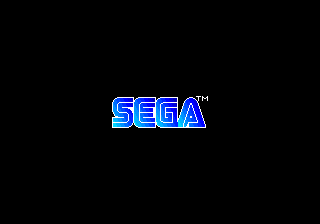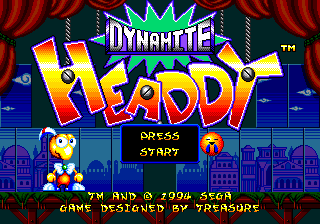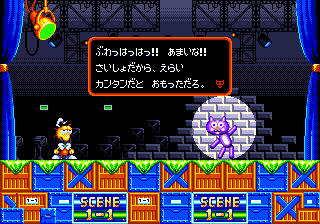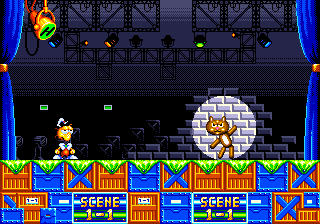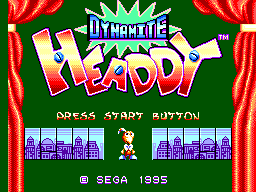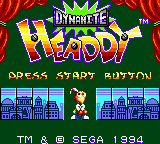- Back to: Dynamite Headdy.
Localisation comparisons
Mega Drive version
Sega logo
The Western versions include a ™ symbol next to the Sega logo.
Title screen
Copyright information for the overseas versions of Dynamite Headdy have been simplified. There is also an expectation that the user knows START is a "button" (although officially the Mega Drive control pad has "triggers", not buttons).
Gameplay comparisons
The player starts with two continues in the Japanese game, but overseas, they start with none.
To get a continue, the player has to collect 10 continue icons after defeating a boss in the Japanese version. This requirement was changed to 13 overseas, and while it doesn't seem like much, it makes getting continues significantly harder.
Graphics comparisons
Health spotlights had letters added to them in the International version. "H" for Headdy, "E" for bosses.
The Head Trip power-up is known as the "Buddha Head" in the Japanese version, and its icon in that version depicts the Kanji symbol for "Buddha" (仏).
Just like with the Sega logo sequence, a trademark symbol was added to every instance of Headdy, Sega and Treasure in the International game.
Level comparisons
Reccuring antagonist Maruyama was painted brown, made to look angry and renamed "Trouble Bruin" for the Western releases. Despite this, samples of the Maruyama name continue to be featured as part of the character's theme song.
The Japanese version of the game also features dialogue in this section. In the West, most of the dialogue was removed outside of the initial tutorial stages, meaning Trouble Bruin is not formerly introduced in-game.
Maruyama/Trouble Bruin's first fight has some differences after attempting to charge into Headdy. He will drop four small orbs that bounce to the right and three large orbs that bounce to the left in the Japanese version, whereas the International game has him create 6 large orbs (technically 8, but two of them go off-screen quickly) that bounce up high, followed by two that bounce to the left. The orbs were also made harmful in the International game.
The tutorial stages all give the player the option to decline training and leave in the Japanese version. This choice was taken away overseas, thus the player is forced to take the training should they enter. There is also no dialogue for failing training.
As a consequence of Maruyama being recoloured, certain enemies and bosses that use his palette line had to be recoloured too.
Rebecca, a giant toy doll fought in Scene 4-1, was replaced with a robot renamed "Mons Meg" overseas.
The fight against Maruyama in Scene 5-2 takes 4 hits to defeat, and has a predictable cycle: he will cut three segments of the tower, charge at Headdy, then repeat the cycle. Trouble Bruin, on the other hand, has double the HP and a seemingly completely random attack cycle, making this fight take much longer to win.
The first wave of enemies in Scene 6-1 is a lone Back Speeder/Flying Shark in the Japanese game. This was changed overseas to a wave of five.
Following the Back Speeder/Flying Shark, the Japanese game has a second wave of Jayrons/Hovers which were taken out of the International game.
The claw that picks up the Sky Jaws/Sky Battleship moves at 1 pixel per frame in the Japanese version, taking 14 seconds to complete the mini-boss intro. This was sped up to 2 pixels per frame overseas.
Just before the fight against Baby Face in Scene 6-4, all three power-up types are supplied to the player. They are spaced apart in the Japanese version, and clumped together internationally.
The boss of Scene 7-1 is Yayoi, a geisha robot. In the Japanese version, she was changed to a generic robot and given the equally generic name of "Gatekeeper".
Her second form, Izayoi, was also changed, along with a rename to the "Nasty Gatekeeper". Her health was also nearly doubled from 9 to 17 HP.
Unlike other bosses in the game, Rever Face/Twin Freaks had his HP reduced from 33 HP to 17 HP in the overseas version. To compensate for the HP reduction, the hitbox of his ear was made smaller, requiring the player to hit the center of his ear.
Dark Demon's HP, like with Izayoi, was nearly doubled from 9 to 17 HP in the International version.
Due to the removal of dialogue internationally, there is a story change after defeating Dark Demon. In the Japanese version, Fingy explains to Smily (the badge worn by Dark Demon) that he is not the greatest puppet, but a prize to be awarded to the greatest puppet, which is Headdy. Upon hearing this revelation, Smily attaches himself to Headdy's face.
None of this happens in the International version. Instead, Heather simply glomps Headdy.
Ending
In the International game, Headdy is seen among his friends, waving goodbye to Heather as she leaves. In the Japanese version, he's not there.
Instead, he is too busy trying to pry Smily off his head. He briefly succeeds, only for Smily to reattach himself.
Version comparisons
Title screen
References

